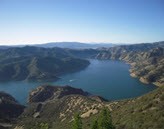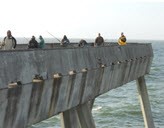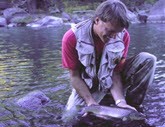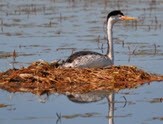
Bioaccumulation Monitoring Program
Background | Bioaccumulation Monitoring Surveys
SWAMP Bioaccumulation Monitoring Program Fact Sheet (3 page PDF)
English |
Spanish |
Simplified Chinese |
Traditional Chinese |
Hmong |
Korean |
Tagalog
SWAMP Bioaccumulation Monitoring Program Flyer (1 page PDF)
English | Spanish | Simplified Chinese | Traditional Chinese | Hmong | Korean | Tagalog
SWAMP Bioaccumulation Monitoring Program Long-Term Monitoring Plan (2025-2029)
Background
The preservation, enhancement, and restoration of California's water resources is vital to the health and well-being of all Californians, Native American Tribes, the economy, and natural lands for present and future generations. The mission of the State Water Resources Control Board and Regional Water Quality Control Boards Bioaccumulation Monitoring Program is to provide statewide monitoring data and information that could be used to:
- Assess and contribute to the protection and restoration of fishing and aquatic life beneficial uses that are impacted by the bioaccumulation of pollutants in California's waterbodies, and
- Assess the human health risks associated with the consumption of contaminated fish and shellfish in California's freshwater and coastal ecosystems, and use that information to support the development of advisories that would inform consumers of significant health risks associated with the consumption of particular species.
In September 2006, the Surface Water Ambient Monitoring Program (SWAMP) formed a subcommittee, the Bioaccumulation Oversight Group (BOG), now known as the Safe to Eat Workgroup (Workgroup) to develop plans for and guide implementation of SWAMP bioaccumulation monitoring.
The California Water Quality Monitoring Council designated the Workgroup as its workgroup for assessing "Is it safe to eat fish and shellfish from our waters?"" and directed this workgroup to develop the Safe to Eat Portal, which is devoted to this theme.
Since the Bioaccumulation Monitoring Program and the Workgroup began conducting bioaccumulation monitoring surveys in 2007, several rounds of trends monitoring have been implemented and corresponding data reports generated. The data from these bioaccumulation monitoring surveys have been the primary basis for the placement of over 130 California lakes and reservoirs on the Clean Water Act Section 303(d) list of impaired waterbodies for mercury. These listings led to the Statewide Mercury Provisions (consisting of mercury water quality objectives and new beneficial use definitions) and a Statewide Mercury Control Program for Reservoirs. Since 2009, the Office of Environmental Health Hazards Assessment (OEHHA) has released over 70 fish consumption advisories based wholly, or in part, on data collected through the Bioaccumulation Monitoring Program, including a statewide advisory for eating fish from California's lakes and reservoirs without site-specific advice, and a statewide advisory in 2016 for eating fish from California coastal locations without site-specific advice.
Efforts are underway to ensure bioaccumulation monitoring continues to be aligned with the public’s needs, particularly in areas where communities rely on fishing for consumption, subsistence, sustenance, and cultural purposes.
Bioaccumulation Monitoring Survey Plans and Reports
Subscribe directly to the Safe to Eat Workgroup Email List
Subscribe to our Workgroup email list to receive notifications and the latest updates. After subscribing, you will need to check your email host for a confirmation email to complete the subscription.
Contact Information
For questions about the Bioaccumulation Monitoring Program or the Safe to Eat Workgroup, please email Anna.Holder@waterboards.ca.gov






